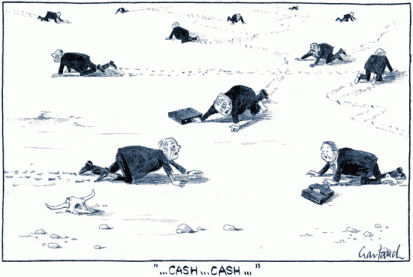
Now that a turning back of the financial deregulation that began under Reagan and continued under Bush I, Clinton and Bush II looks imminent, what U.S. President is most to blame for the current crisis? Patrik Etschmayer writes for Switzerland’s Nachrichten, “Only when regulations were relaxed under Ronald Reagan did the first rather costly banking disaster ensue: The Savings and Loan crisis. This led to the recession of the early 1990s, which helped secure Bill Clinton’s 1992 electoral victory. But Clinton didn’t heed the warning. Even though it is now no longer discussed, and all fingers point toward George W. Bush – his actions alone could not have resulted in today’s disaster. … Clinton worked until almost the end of his term to abolish Glass-Steagal. The Congress fought him for years just as it had under Reagan and Bush the First. But in 1997, the FED Board of Directors under Alan Greenspan eliminated rules that limited securities trading for savings banks.”
In explaining why things have gone so badly that stricter banking rules are now necessary, Etschmayer writes, “Legal regulation seems to be the only way to rein in the apparently boundless greed – because bankers, speculators, hedge-fund managers and other stock market players large and small – and not only in the United States – seem to have lost the capacity to distinguish between freedom and foolishness.”
By Patrik Etschmayer
Translated By Patrik Etschmayer
March 31, 2008
Switzerland – Nachrichten – Original Article (German)
The promises were big and for several years the results seemed to confirm the prophets: The deregulation of the U.S.-banking system in 1999 opened up unbelievable opportunities in the United States for international and national banks to make money and amass power.
After 1933, as a consequence of the investment panic of 1929 and the subsequent Great Depression, the U.S. put into force the Glass-Steagal Act . After the passage of this law, it was no longer possible for U.S.-Banks to take part in the savings and loan business as well as trade in securities [stocks].
As a result there was a curtailment of smaller, regional banks – strict controls were imposed on these institutions. It might have been an economic disadvantage, but on the other hand, one must recognize that the United States went another 50 years without another banking crisis.
Only when regulations were relaxed under Ronald Reagan did the first rather costly banking disaster ensue: The Savings and Loan crisis . This led to the recession of the early 1990s, which helped secure Bill Clinton’s 1992 electoral victory. But Clinton didn’t heed the warning. Even though it is now no longer discussed and all fingers point toward George W. Bush – his actions alone could not have resulted in today’s disaster. That required something more. One of Clinton’s central slogans was that the “Era of Big Government” was over, and that from now on, the State would stay out of the economy.
Clinton worked until almost the end of his term to abolish Glass-Steagal. The Congress fought him for years just as it had under Reagan and Bush the First. But in 1997, the FED Board of Directors under Alan Greenspan eliminated rules that limited securities trading for savings banks.
READ ON AT WORLDMEETS.US, along with continuing translated foreign press coverage of the unfolding financial crisis.
















